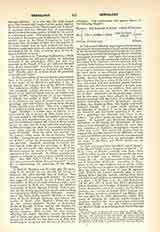

General Chapter (Lat. capitulum, a chapter): The daily assembling of a community for purposes of discipline and administration of monastic affairs has always included the reading of a chapter of the rule, and thus the assembly itself came to be called the chapter and the place of meeting the chapter-house. The qualifying word conventual, provincial, or general, explains the nature of the meeting, and a general chapter, therefore, is one composed of representatives of a whole order or congregation or other group of monasteries. Historically, general chapters, or the germ from which they developed, can be traced back to St. Benedict of Aniane in the beginning of the ninth century. Although his scheme of confederation did not outlive its originator, the idea was revived a century later at Cluny. The example of Cluny produced imitators, and abbeys like Fleury, Dijon, Marmoutier, St-Denis, Cluse, Fulda, and Hirsau (or Hirschau), became centers of groups of monasteries in which a more or less embryonic system of general chapters was introduced. Later on, Citeaux, Camaldoli, Monte Vergine, Savigny, and other reforms, elaborated the idea, which resulted eventually in the congregational system inaugurated by the Fourth Lateran Council in 1215, and since that date it has been the almost invariable custom of every order or congregation. The constitution, times of meeting, and powers of a general chapter, however, vary so much in the different religious orders that it is impossible to generalize on these points. At Citeaux, for instance, the chapter met at the mother-house every year, and was, in theory, attended by all the abbots of the order. In other orders the meeting of chapters was held every three or four years, and this has remained the more general usage till the present day. In those that are divided into provinces, the provincial superiors, and sometimes some other officials as well, presided over by the general, if there be one, form the chapter; in others, the superiors of all the houses. Amongst Benedictines, each congregation has its own separate chapter, which is composed usually of the abbot and an elected delegate from each monastery, with the president of the congregation at their head. A general chapter usually elects the general or president of the order or congregation, sometimes appoints the various superiors and other officials, settles matters of business and discipline, hears appeals from its subjects, and in some cases also has the right to draw up or sanction changes in its constitutions. Subject of course to the Holy See, it represents the highest authority in its own particular order or federation. For more detailed descriptions as to the composition and powers of general chapters, the separate articles on the various religious orders must be consulted.
G. CYPRIAN ALSTON

